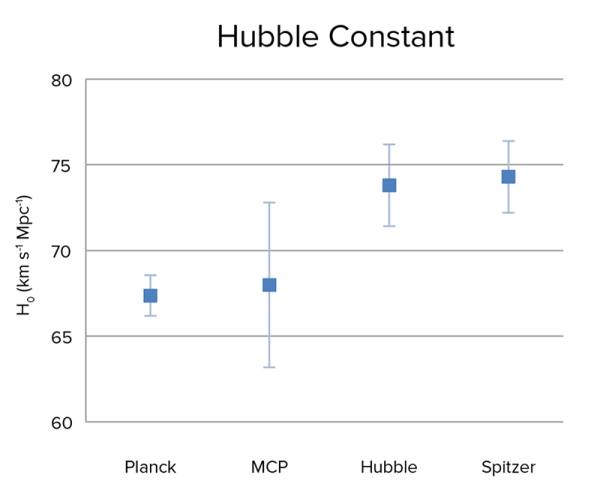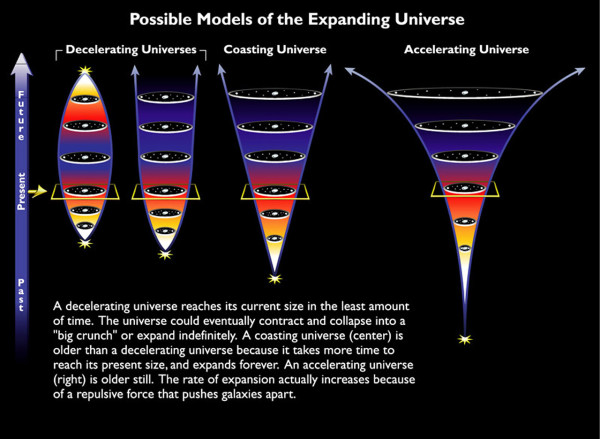"That’s all regular matter, just five percent. A quarter is “dark matter,” which is invisible and detectable only by gravitational pull, and a whopping 70 percent of the universe is made up of “dark energy,” described as a cosmic antigravity, as yet totally unknowable. It’s basically all mystery out there - all of it, with just this one sliver of knowable, livable, finite light and life." -Summer Brennan
The Universe could have had any number of fates, even given that it started out with a hot Big Bang. Gravitation could have overcome the initial expansion, eventually causing a recollapse and a big crunch. The expansion could have been too great, and caused a runaway expansion that always slowed but never ceased. Yet the Universe gave us a surprising option that was none of the above: acceleration due to dark energy.
It's our measurements of astrophysical objects at great distances and the fluctuations of the cosmic microwave background that allowed us to determine our expansion history. Yet those two sources, when we look at them in detail, give results that conflict with one another! Does this mean that one of the measurements is problematic? Or, perhaps more excitingly, does that mean dark matter or dark energy is changing over time?
 Image credit: James Braatz / NRAO. You can clearly see how the Planck results (left-most point) disagree with the Hubble results for the value of the expansion rate of the Universe.
Image credit: James Braatz / NRAO. You can clearly see how the Planck results (left-most point) disagree with the Hubble results for the value of the expansion rate of the Universe.
Come get the latest scoop on the biggest problem with the expanding Universe!
- Log in to post comments






The Biggest Problem With The Expanding Universe Might Be Trouble For Dark Energy
“According to the [Cosmic Microwave Background], the rate that the Universe is expanding today (the Hubble rate of expansion) is 67±1 km/s/Mpc, while according to the other (distance ladder) method, that rate is 74±2 km/s/Mpc. This might not seem like such a big deal, as you might say to yourself, “maybe it’s somewhere between the two values: 70 looks about right.” But these uncertainties are now so small that the two possible measurement values do not overlap. Instead, we’re left with only two possibilities:
1.There’s a FUNDAMENTAL FLAW in one of the methods used: perhaps the ASSUMPTIONS and INFERENCES of the CMB are INCORRECT, or perhaps our inability to calibrate the smaller distances on the distance latter are skewing us away from the true values.
2.Or, more excitingly…”
You’ll have to read the rest yourself.
Science in action! Uncertainies, questioning assumptions, posing new questions and research paths to address those questions.
None of which is remotely applicable, and must be utterly incomprehensible, to someone with a magical worldview driven by untestable and unsupported assertions.
Just a pile of paraphrasing with misspelling .............
Absolutely, Mr Kelsey. The default direction of science is FORWARD, even if you can't see where you're going.
@MandoZink #4: That what we all like to think! However, the actual path of science often seems more like natural selection than progress to me :-)
What's hilarious about ethans possibility 1, possibility 2 and more-excitingly possibly 3, is that the simplest explanation is studiously overlooked
"The default direction of science is FORWARD, even if you can’t see where you’re going."
Whereas the default direction of religion is inward, even if you end up inside your own anus. But at least there all the voices you hear agree with you.
"more-excitingly possibly 3, is that the simplest explanation is studiously overlooked"
A possibility so simple you simply cannot write it down...?
The Universe is expanding based on observations that stars 500 million light years away are more red shifted (moving away faster) than stars 100 million light years away. However locally (say the Andromeda galaxy) is actually moving towards us. It seems to me that closer objects are the source of more recent information. Thus perhaps the star 100 million light years away was moving away faster 500 million years ago but has since SLOWED DOWN as will alos occur for the star that is now 500 million light years away if we wait long enough.
@robert #9: You might find it useful to (a) update your knowledge, since what you describe is the 1920's-era initial data for an expanding univers; and (b) actually read Ethan's posts before commenting.
We have data for galaxies and galaxy clusters out to billions (many billions) of light years. When an astronomer talks about "z = 7" galaxies, that means galaxies with measured redshifts of a factor of 7!
Beyond about z ~ 0.1 or so (our local group), redshift is universally observed (pun intended). The variety of both positive (moving away) and negative (moving toward us, or "blue") redshifts among the most nearby galaxies is due to that entire system being bound together gravitationally.
That means that we are all moving round the common center-of-mass of the Local Group, and so we see some pairs moving closer together, some moving apart, and some moving perpendicularly to one another.
This isn't a surprise to any professional astronomer, nor does it have any pertinence on the cosmological expansion, even if it is a surprise to you.
Michael says "This isn’t a surprise to any professional astronomer"
It's not a surprise because there is a rough way to explain as you say. But there's a lot of peculiar action where we are, and I'm under the impression that according to theory, the local effects place us in a region that is atypical. Or is that wrong?
It's wrong, Chris. Ethan did go into it in one of the recent comments of the week threads.
We're not atypical. At least no less atypical than you'd expect to find (similarly, if you happened to be EXACTLY the average, that's really rather atypical).
To Chris Mannering #11:
I think you’re on to something there.
Contrary to what Michael’s words might lead many to believe, the space scientists are surprised, even shocked, just about every day with what they’re finding.
Here’s an example.
“Then we looked. And what did we discover?
“Big gassy planets *not where they should be*...
“Which means these once-cold planets are now, *puzzlingly*, hot…
“... How odd…
“As of this month, we've discovered 884 planets, 692 planetary systems, 132 of them with more than one planet and, strange to tell, almost none of them look like us.
"We are now beginning to understand that nature seems to overwhelmingly prefer [planetary] systems that have multiple planets with orbits of less than 100 days," says Steve Vogt, astronomer at the University of California, Santa Cruz. "This is quite unlike our own solar system, where there is nothing with an orbit inside that of Mercury. So our solar system is, in some sense, a bit of a *freak* and not the most typical kind of system that Nature cooks up."
“So our solar system is ... a bit of a freak.
“… Mike Brown, an astronomer at Caltech, wrote me that while everybody is busy hunting for an Earth-like planet, they missed this story. "Before we ever discovered any [planets outside the solar system] *we thought we understood* the formation of planetary systems pretty *deeply*." We had our frost line. We knew how solar systems formed. "It was a really beautiful theory," he says. "And, clearly, *thoroughly wrong*."
“It is something I find *deeply weird*.
“As the discoveries roll in, Mike is *getting more and more uncomfortable*.”
http://www.npr.org/sections/krulwich/2013/05/06/181613582/our-very-norm…
………….
But I think, generally speaking, the space scientists will continue to hold on to models that are broken down and wildly inaccurate, rather than have no model at all or start a new model from scratch.
Because at least the broken down, wildly inaccurate models tell them the most important thing:
That the universe is billions of years old.
Pure projection, See Nowt.
Yeah, it sucks when your science points to reality.
Oh wait, no it doesn't. Only a moron like you thinks there is a problem with acknowledging the reality of the universe.
I'm not a scientist, just a navigator, with experience at the sea / astronomical navigation,In my understanding the expanding universe theory isn't correct. If this theory was correct, celestial bodies will expand, and the form of constellations will change from year to year.But in reality, form of constellations do not change.
Nice article,thank you.
@16, Gatot Soedarto
Get hold of star charts for epoch 1900, 1950, and 2000. Compare the relative positions of the stars in each issue, then reconsider your statement. :)
So 70% of the universe is dark energy. We don't know what dark energy is. A Cartesian syllogism leads us to: we don't know what 70% of the universe is. Hmmm.
So what? We don't know what self awareness is, nor what constitutes life and non-life.
We don't even know what the hell your problem is.
Hmmmm?
In all fairness, 70% of the Universe's ENERGY DENSITY is dark energy. Not 70% of Universe.
Even though many scientists who should really know better use that phrase, I think they are doing more disservice and spreading even more misconception of what DE is and isn't.
@ Gatot
What you have to realize is that the effect of DE is so small and insignificant on the scales of our everyday scales. It's only the cumulative effect over intergalactic expansions and then over long stretches of time, that it becomes evident and measurable.
Stars that form constelations are all within our galaxy and very close by, effects of DE are not visually apparent on that scale. And especially not in several years time.
On the other hand, constelations do move and evolve as stars move within the galaxy. What you see in the sky today, and what someone saw 100.000 years ago is different. But again not because of DE